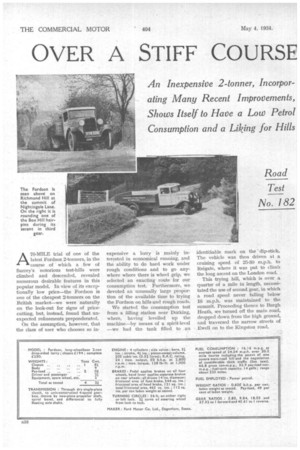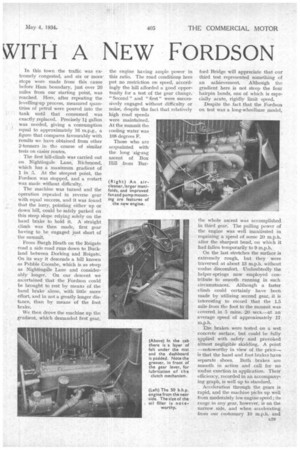OVER A STIFF COURSE
Page 42

Page 43

Page 44

If you've noticed an error in this article please click here to report it so we can fix it.
WITH A NEW FORDSON
An Inexpensive 2-tonner, Incorporating Many Recent Improvements, Shows Itself to Have a Low Petrol Consumption and a Liking for Hills
A70-MILE trial of one of the latest Fordson 2-tonners, in the course of which a few of Surrey's notorious test-hills were climbed and descended, revealed numerous desirable features in this popular model. In view of its exceptionally low price—the Fordson is one of the cheapest 2-tonners on the British market—we were naturally on the look-out for signs of pricecutting, but, instead, found that unexpected refinements preponderated.
On the assumption, however, that the class of user who chooses so in
expensive a lorry is mainly interested in economical running, and the ability to do hard work under rough conditions and to go anywhere where there is wheel grip, we selected an exacting route for our consumption test. Furthermore, we devoted an unusually large proportion of the available time to trying the Fordson on hills and rough roads.
We started the consumption test from a filling station near Dorking, where, having levelled up the machine—by means of a spirit-level —we had the tank filled to an
identifiable mark on the dip-stick. The vehicle was then driven at a cruising speed of 25-30 m.p.h. to Reigate, where it was put to climb the long ascent on the London road.
This trying hill, which is over a quarter of a mile in length, necessitated the use of second gear, in which a road speed never falling below 10 m.p.h. was maintained to the summit. Proceeding thence to Burgh Heath, we turned off the main road, dropped down from the high ground, and traversed the narrow streets of Ewell on to the Kingston road.
In this town the traffic was extremely congested, and six or more' stops were made from this cause before Ham boundary, just over 20 miles from our starting point, was reached. Here, after repeating the levelling-up process, measured quantities of petrol were poured into the tank until that consumed was exactly replaced. Precisely 11 gallon was needed, giving a consumption equal to approximately 16 m.p.g., a figure that compares favourably with results we have obtained from other 2-tonners in the course of similar tests on easier routes.
The first hill-climb was carried out on Nightingale Lane, Richmond, which has a maximum gradient of 1 in 5. At the steepest point, the Fordson was stopped, and a restart was made without difficulty.
The machine was turned and the operation repeated in reverse gear with equal success, and it was found that the lorry, pointing either up or down hill, could be safely parked on this steep slope relying solely on the hand brake to hold it. A straight climb was then made, first gear having to be engaged just short of the summit.
From Burgh Heath on the Reigate road a side road rims down to Buckland between Dorking and Reigate. On its way it descends a hill known as Pebble Coombe, which is as steep as Nightingile Lane and considerably longer. On our descent we ascertained that the Fordson could be brought to rest by means of the hand brake alone, with little more effort, and in not a greatly longer distance, than by means of the foot brake.
We then drove the machine up the gradient, which demanded first gear, the engine having ample power in this ratio. The road conditions here put no restriction on speed, accordingly the hill afforded a good opportunity for a test of the gear change. " Second " and " first " were successively engaged without difficulty or noise, despite the fact that relatively high road speeds were maintained. At the summit the cooling water was 168 degrees F.
Those who are acquainted with the long zig-zag ascent of Box Hill from Bur ford Bridge will appreciate that our third test represented something of an achievement. Although the gradient here is not steep the four hairpin bends, one of which is especially acute, rigidly limit speed.
Despite the fact that the Fordson on test was a long-wheelbase model, the whole ascent was accomplished in third gear. The pulling power of the engine was well manifested in regaining a speed of some 20 m.p.h. after the sharpest bend, on which it had fallen temporarily to 9 m.p.h.
On the last stretches the surface is extremely rough, but they were traversed at about 13 m.p.h. without undue discomfort. Undoubtedly the helper-springs now employed contribute to smooth running in such circumstances. Although a faster climb could certainly have been made by utilizing second gear, it is interesting to record that the 1.5 mile-from the foot to the summit was covered in 5 mins. 20 secs.—at an average speed of approximately 17 m.p.h.
The brakes were tested on a wet concrete surface, but could be fully applied with safety and provoked almost negligible skidding. A point —noteworthy in view of the price— is that the hand and foot brakes have separate shoes. Both brakes are smooth in action and call for no undue exertion in application. Their efficiency, recorded in an accompanying graph, is well up to standard.
Acceleration through the gears is rapid, and the machine picks up well from moderately low engine speed ; its range in any gear, however, is on the narrow side, and when accelerating from our customary 10 m.p.h. and
5 m.p.h. in " top " and " third " slight hesitation and juddering were, in both cases, noticeable at the outset. This brings to mind a period of engine vibration that is marked at a fast tick-over, but absent throughout the remainder of the range of r.p.m., both above and below this critical speed.
In general the roadworthiness and ease of control are first class, and the steering light, positive and stable. Our tests were well calculated to bring to light any weakness in these respects. We are confident in the opinion that it would be possible to drive for long periods without fatigue, and maintain good averages under bad road conditions.
In this connection, among the
recent improvements made to the Fordson is the lengthening by 2 ins. of the clutch and brake pedal arms. This allows a longer stroke and, consequently, lengthens periods between adjustment. A similar lengthening of the lever has en' hanced the efficacy of the hand brake. A refinement is the provision of a two-position rest for the accelerator foot.
Other useful features include a combined ignition and steering lock, bolted to the steering column, and locks for both the cab doors. A ventilator is incorporated in the scuttle, and the large window in the back of the cab, like the windscreen, is of Triplex.
The petrol tank is now placed under the seat, and the accumulator beneath the floorboards, a trap-door being provided above it. Lubrication of the clutch-withdrawal mechanism on these new models is effected by an accessible greaser, mounted on the floorboards, which requires replenishing every 1,000 miles.
New features of the engine include a balanced crankshaft, which has
2-in, diameter journals and B30 crankpins, the use of forced lubrica-, tion to the main and camshaft bearings, and a lighter flywheel, which now weighs 52 lb. 2 oz. There is an improvement in the fan and waterpump mounting, this unit, in its latest form, being entirely separate
from the cylinder casting, to a face on the front of which it is bolted.
The engine and gearbox are mounted on rubber and the former is so constructed that should it be required to install a new-type power unit in An old-type chassis, this can easily be done. The rear bearers are detachable to facilitate removal of the gearbox, without disturbance of the engine.
In the back axle the taiIshaft has an outrigger bearing, and a practical, if unusual, detail is the provision of an emergency bearingto support the back of the crown wheel when under excessive thrust from the bevel pinion. This takes the form of a metal pad which is normally clear of the wheel by a few thousandths. Three of the studs holding the floating-axle flanges to the wheel hubs are provided with split-coned washers accurately to locate the flange.
It would be possible to enumerate countless points throughout the chassis designed to afford durability and efficient service, but to do so would be beyond the scope of this article. As we mentioned earlier, we set out to prove the Fordsori thoroughly suitable for hard work and chose our testing gronnd accordingly. It gave us satisfaction, as it should to all in whose service it may be operated.




























































































